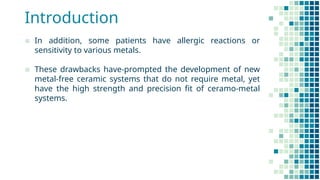Recent advances in dental ceramic -machinable ceramics.pptx
- 2. Contents ▪ Introduction ▪ Definitions ▪ History ▪ Composition ▪ Strengthening of Ceramics ▪ Classification ▪ Materials used in All Ceramic Restoration ▪ Etching and silanating ▪ Conclusion
- 3. Introduction ▪ Strength concerns compromised some of the beauty of porcelain crowns. ▪ Because of the relatively low tensile strength and brittleness of the porcelain, it has been generally fused to a metal substrate to increase resistance to fracture. ▪ However, this metal base can affect the aesthetics of the porcelain by decreasing the light transmission through the porcelain.
- 4. Introduction ▪ In addition, some patients have allergic reactions or sensitivity to various metals. ▪ These drawbacks have-prompted the development of new metal-free ceramic systems that do not require metal, yet have the high strength and precision fit of ceramo-metal systems.
- 5. Introduction ▪ The word “ceramics” is derived from keramikos, which is the ancient Greek word for "earthen", and most commonly used for inorganic materials consisting of one or more metals combined with a non-metallic element, usually oxygen. ▪ Dental ceramic technology is one of the fastest growing areas of dental materials research and development.
- 7. Historical Background ▪ Approximately 1774, a Parisian apothecary Alexis Duchateau, with assistance of a Parisian dentist Nicholas Dubois de Chemant, made the first successful porcelain dentures. ▪ Land (1889) describes a method of improving the fit of “porcelain fillings” by burnishing platinum foil directly into the preparation. ▪ With the industrial revolution, the manufacture of porcelain denture teeth increased.
- 8. Historical Background ▪ In 1950s , with development of acrylic resins in dentistry , the use of porcelain declined . ▪ The development of and successful use of porcelain fused to metal in 1960s restored the use of porcelain in fixed prosthodontics. ▪ The first comercial porcelain was developed by Vita Zahnfabrik in about 1963. ▪ In 1965 , Mc lean and Hughes developed dental aluminous core ceramic consisting of glass matrix containing between 40 and 50 % Al2O3
- 9. Historical Background ▪ In 1968 , MacCulloch first proposed the use of glass ceramic in dentistry. ▪ He used a continuous glass-molding process to produce denture teeth. ▪ He also suggested that it should be possible to fabricate crowns and inlays by centrifugal casting of molten glass.
- 10. Historical Background ▪ In 1970s and 1980s , the porcelain fused to metal restorations became the primary restoration of choice for many clinicians . ▪ In the 1980s and early 1990s , patient demands for improved esthetics results have led to the development of many ceramic systems .
- 11. Historical Background ▪ Glass infiltrated ceramics (INCERAM ) were introduced in 1988. The strength of these ceramics is about 3 to 4 times greater than earlier alumina core material. ▪ In 1990s , pressable glass-ceramics ( IPS Empress ) containing approximately 34 vol % leucite was introduced that provided a strength and marginal adaptation .
- 12. Historical Background ▪ CAD/CAM has been introduced into dentistry as early as 1970 which has now revolutionized the designing and processing of all ceramic crowns and bridges by cutting down the time for impression making and processing of the ceramic crowns and bridges. ▪ First chair side-produced ceramic inlay based on CAD-CAM unit (Cerec, Siemens) was introduced in 1985. ▪ Procera system was introduced in 1993.
- 13. Historical Background ▪ Second generation Cerec system i.e. Cerec-2, was introduced in 1994. ▪ Third generation Cerec system i.e. Cerec-3, was introduced in 2000.
- 15. Classification According To Firing Temperature High fusing >1300(°C) Medium fusing 1101 – 1300(°C) Low fusing 850 – 1101(°C) Ultra low fusing <850(°C)
- 16. According to the technique of Fabrication Conventional powder slurry system Medium fusing Felspathic porcelain Aluminous porcelain DUCERAM LFC (Degussa) OPTEC HSP (Jeneric/Pentron) Castable Ceramics Dicor Cerapearl (Kyocera Inc.) Pressable ceramics IPS Empress I, II , cosmo, (Ivoclar) Optec pressable ceramics (Jeneric/Pentron) Cergo (Dentsply ) VitaPress ( Vitadent ) Glass infiltrated ceramics In-Ceram aluminia (Vident) In-Ceram spinell (Vident) In-Ceram zirconia (Vident) Injection molded ceramics Alceram (Cerestore) Machinable ceramics CAD CAM Cerec: Vita Mark I, Vita Mark II, Dicor MGC ( Machinable Glass Ceramic) Procera Cercon base VitaBloc alumina , spinell & zirconia Lava frame Celay(coping milling)
- 17. Application of CAD/ CAM techniques was actively pursued by three groups of researches Group supported by Henson International of France. Combined group effort between the University of Zurich and Brains, Brandestini Instruments of Switzerland. University of Minnesota, supported by the U.S. National Institute of Dental Research.
- 18. French system Optical impression – Laser scanner Data processing – By Shape recognition software It has a library (memory) describing theoretical teeth. The system uses: 3-D probe system based on electro-optical method Surface modelling and screen display Automatic milling by a numerically controlled 4-axis machine
- 19. Swiss system Optical impression - Optical topographic scanning using a 3-D oral camera Data processing - By an interactive CAD unit The system uses: A desk top model computer Display monitor permitting visual verification of quality of data being acquired Electronically controlled 3-axis N/ C milling machine
- 20. Minnesota system Optical impression - Photograph based system using a 35-mm camera with magnifying lens. Data processing - Data obtained in the dental office is sent to another location for processing and machining. 3-D Reconstruction uses : Direct line transformation and an alternative technique proposed by Grimson Milling with a 5-axis N/ C machine.
- 21. MACHINABLE CERAMICS Digital systems I. Direct II. Indirect i. 3-d scanning ii. Cad modelling iii. fabrication Analogous system I. Copy milling II. Erosive techniques i. Fabrication of prototype for scanning ii. Copying and reproduction
- 22. DIGITAL SYSTEMS: CAD-CAM(10-15mins) The prepared tooth is scanned---3d miniature camera Microprocessor unit stores the pattern Video display serves as a format for manual construction Final 3-d restoration is developed from above again by microprocessor Electronic information is transferred to miniature 3-axis milling device Milling device generates a precision fitting restoration from a standard ceramic block
- 23. Cerec system Brains. A. g. ------switzerland------1980. West germany-----siemens group. Ceramic reconstruction system. Consists of: 3-d video camera(scan head). Electronic image processor with memory unit. Digital processor. Miniature Milling machine.
- 24. Materials involved : Vita mart II, Dicor MGC and Pro Cad Sanidine KAlSi3O8 Mica crystals 70% Leucite containing ceramic Optical scanning
- 25. Clinical advantages of cerec systems: o Translucency and color of porcelain very closely to natural dental tissues. o Quality of ceramic is not changed during processing. o Can be placed in one visit. o Prefabricated ceramic is wear resistant. Short comings: Occlusal anatomy to be developed Inaccuracies in fit Poor esthetics
- 26. The compact, mobile unit consists of three components: a small camera, a computer screen and a three – axis – of – rotation milling machine.
- 27. CEREC 2 SYSTEM Morman & brandestini-----1994. Constant further development. Major changes include: Enlargement of grinding unit from 3 to 6 axes. Sophisticated software technology---occlusal surfaces. Minor technical innovations: Magnification factor increased from x8 to x12. Monitor can be swiveled and tilted. Improved grinding precision by 24 times. Improved accuracy of fit.
- 28. Cerec 3 system Operator can record multiple images in seconds. Cerates a virtual cast for entire quadrant. Additional step bur----enhances precision. In general these restorations are bonded to tooth structure by : Etching . Conditioning. Cementation with luting agents.
- 29. Akbar, walker, williams(2006) Finish lines and marginal fit-----statistically significant(chamfer, Shoulder both acceptable)
- 30. DURET SYSTEM Francois Duret-----produced by sopha(France) Camera module Cad module Milling module Access articulator linked to cad unit. CICERO SYSTEM Computer integrated crown reconstruction Ceramic fused to metal restoration Optical scanning Net shaped metal and ceramic sintering (different layers can be achieved)
- 31. COMET SYSTEM Co-ordinate measuring technique. For imaging 2 –d line grids are projected. Mathematical reproduction of tooth surfaces. Digitalization , feed back, visual monitor image.
- 32. Two classes of machinable ceramics are available: 1) FINE SCALE FELDSPATHIC PORCELAIN. I.CEREC VITABLOC MARK I: feldspathicporcelain larger partical size(10-50micron) II. CEREC VITABLOC MARK II: feldspathic porcelain reinforced with aluminium oxide(20-30%) fine grain size(4 micron) 2) GLASS PORCELAIN I. DICOR flurosilica mica crystals Mica plates (2 microns)
- 33. II. MGC F Tetrasilica mica (enhance fluorescence,machinability) III. PRO CAD: leucite-reinforced glass ceramic (high strength)
- 34. Advantages of machineable ceramics over other systems: Single visit Good patient acceptance Eliminates procedures like impression model making and fabrication of temporary prosthesis. Void free porcelains with out firing shrinkage. Better adaptation Inlay onlay can be fabricated chair side Eliminates the asepsis link Since its computer assisted crowns of correct dimensions can be obtained Glazing is not required----can be polished Less abrasion of tooth structure----homogenous material Mobile character of entire system
- 35. DISADVANTAGES: × Limitations in fabrication of multiple units. × Inability to characterize shades and translucency. × Inability to image in wet environment. × Technique sensitive. × Expensive. × Limited availability.
- 36. Fabrication of proto type( impression making, model preparation) Replica of inlay/crown is made. Its fixed on copying device Transferred on to chosen material Materials used: Composite ---sono erosion--sonotrodes ceramic----- sono erosion—sonotrodes metal-------spark erosion---dielectric fluid COPY MILLING
- 37. Switzerland-------1992 High precision manually operated Key duplication Blue light cured resin------Tracing tools CELAY SYSTEM Sorenson 1994 : marginal fit of CELAY > CEREC
- 38. Advantage : recreation of al surfaces.
- 40. ANDERSON. M. & ODEN. A Nobel Biocare + sandvik hard materials Powder technology + cad/cam technology PROCERA SYSTEM Contact scanner
- 41. Shape on computer screen
- 42. All ceramic Porcelain fused to ceramic
- 43. Conclusion ▪ Research and developments were carried out to improve strength comparable to metal ceramic restorations ▪ The highest-strength materials may be suitable for high- stress applications, including FDPs. However, they are relatively new and still lack the support of long-term clinical experience and research.
- 44. References ▪ Anusavice KJ, Shen C, Rawls HR. Phillips' Science of Dental Materials: Elsevier Health Sciences; 2014. ▪ Rosenstiel SF, Land MF, Fujimoto J. Contemporary Fixed Prosthodontics: Elsevier Health Sciences; 2015. ▪ Shillingburg HT, Sather DA. Fundamentals of Fixed Prosthodontics: Quintessence Pub.; 2012. ▪ Malone WFP, Tylman SD, Koth DL. Tylman's Theory and Practice of Fixed Prosthodontics: Ishiyaku EuroAmerica; 1989. ▪ The Glossary of Prosthodontic Terms. J Prosthet Dent.94(1):10-92. The Glossary of Prosthodontic Terms. J Prosthet Dent.94(1):10-92. ▪ Rosenblum MA, Schulman A. A review of all-ceramic restorations. The Journal of the American Dental Association. 1997 Mar 31;128(3):297-307.
- 45. THANK YOU !!












































